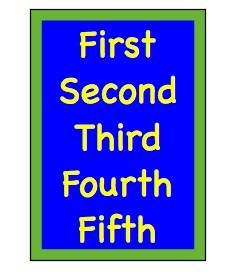Ordinal numbers aren’t just a kindergarten math skill, but are also concepts that your child will continue to study in first grade and second grade. The following fun activities will help your child become more comfortable with the concept of ordinal numbers.
What Is It?
Ordinal Numbers are not really numbers at all; they are actually words. They tell us the position of something in a series. For example, the words first, second, and third are all ordinal numbers. We use ordinal numbers often in everyday life, but the transition from regular numbers to ordinal numbers will not necessarily be obvious to your child. Some of the ordinal numbers sound like their ordered number, such as fourth and four, while others don’t sound anything like their ordered number, such as first and one.
Tips/Activities
Your child has probably heard you using ordinal numbers, and she may have used a few of them herself. For instance, in the U.S., we tend to say “first grade” or “second grade.” Here are a few activities that you can easily do with your child to practice ordinal numbers.
ORDINAL MATCH-UP Materials: 20 index cards, marker
- Write out each one of the following words and numbers on an index card, one number or word per card. When you are finished, you should have 2o cards. FIRST, SECOND, THIRD, FOURTH, FIFTH, SIXTH, SEVENTH, EIGHTH, NINTH, TENTH, 1, 2, 3, 4, 5, 6, 7, 8, 9, and 10.
- If your child can read her number words, ask her to try to find some number words “hiding” inside some of the words (ex: six inside the ordinal word sixth). If she has a difficult time doing this, go ahead and put a box around any of the number words on the index cards to help her.
- Next, ask her what the word first means. She might give you examples, such as “I was first in line.” Talk to her about this being like the number 1, since 1 is the first number (after zero) when we count. Ask her if she knows what second means. If she doesn’t know, tell her it’s like the number 2. Go through all the ordinal numbers up to tenth.
- Now ask her to try to match each ordinal number on the index cards with their number partners (ex: first and 1 would go together).
ORDINAL GO-FISH Materials: 20 index cards from previous activity, book or binder to act as a divider
Children who are familiar with the Go Fish card game will love this math game.
- Place the book or binder on the table or on the floor between the two players to act as a wall.
- Mix up all 20 index cards. Deal out 5 cards to your child and 5 cards to yourself. Spread out the remaining cards upside down in the “fish pond.”
- Each player looks at her cards to see if she has a matching pair of ordinal words and numbers. If she does, she puts the pair off to the side.
- In turn, each player asks the other player for a match for one of her cards. For example, you might say, “Do you have a match for the word fourth?” If she has the number 4, she must give it to you, and you have created a matched pair that you can put off to the side.
- The player with the most matched pairs is the winner.
CEREAL BOWL SORT Materials: 10 cereal bowls, 10 index cards with ordinal words from previous activity, several small items such as macaroni noodles
- Line up the 10 bowls on the table. Place an index card in front of each bowl, in order. If your child is able to help you put them in order at this stage, go for it!
- Ask your child to perform certain tasks. She will have to be a good listener for this activity! Some examples: “Put 3 macaroni noodles in the fifth bowl.” “Put 8 macaroni noodles in the second bowl.” “Take out 2 macaroni noodles from the fifth bowl.” “Put 4 macaroni noodles in the bowl that comes after the sixth bowl.” “Put 5 macaroni noodles in the bowl that comes before the second bowl.”
- Watch as your child places the macaroni noodles in each bowl and correct as necessary.
- Count up all the macaroni noodles in ALL the bowls at the end!
ORDINAL NUMBERS WITH LETTERS
- Be sure to show your child how we often write ordinal numbers: with a number and letters. For example, we write 1st, 2nd, 3rd,4th, 5th, 6th, 7th, 8th, 9th and 10th.
What to Watch For
- The ordinal numbers first, second, and third are the most difficult because they do not sound like their number counterparts.
- Your child does not need to know how to spell the ordinal numbers at this stage, but if she is interested, be sure to point out that fifth does not have a v in it like five, that eighth only has one t at the end, and in the word ninth, we drop the e.
- If you decide to show your child the ordinal numbers past twentieth, watch that she doesn’t say “twenty-oneth” for “twenty-first.”
Want More?
- As always, playing math games at home is a great way to reinforce math skills learned in school.
- Have questions or ideas about this story?
- Need help or advice about your child’s learning?
- Have ideas for future Parent Homework Help stories?
Go to “Leave a Reply” at the bottom of this page. I’d love to help!


Comments on this entry are closed.